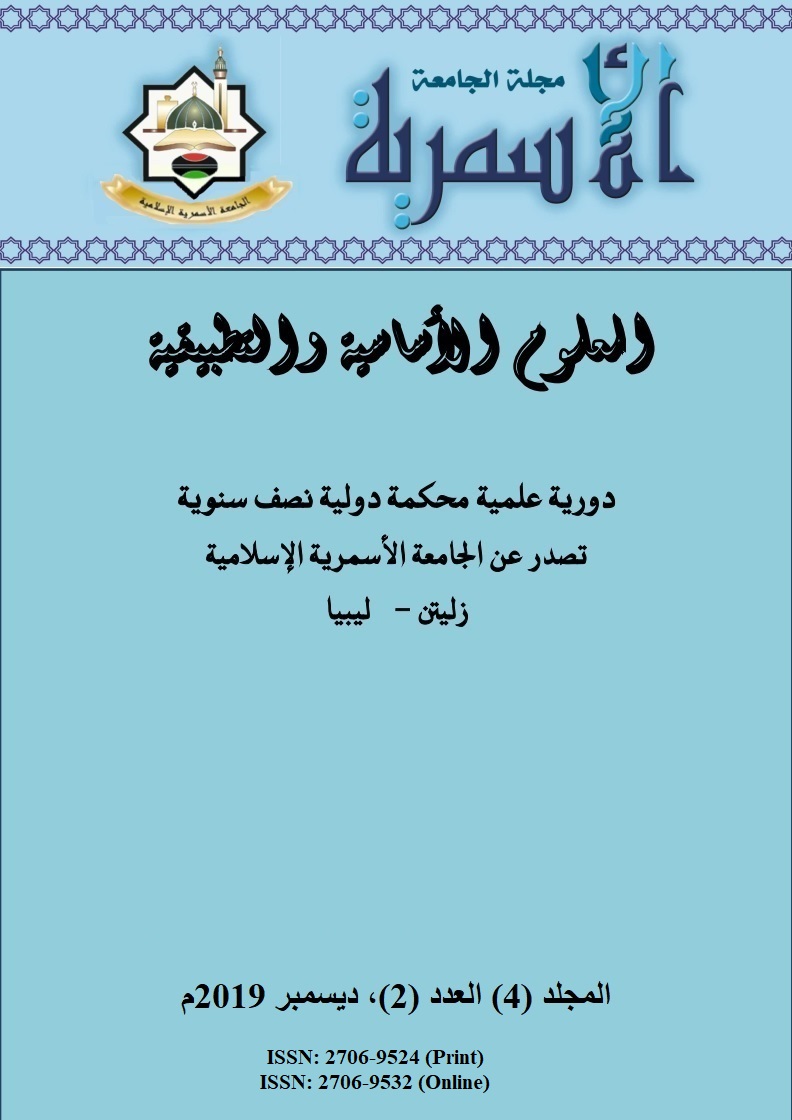دراسة تحليلية لتأثير عوامل التشغيل الرئيسية على معدل نقل كتلة الأوزون في الخلاط الثابت الكينيكي باستخدام نموذج التدفق الرجعي في الحالة المستقرة (BFCM)
DOI:
https://doi.org/10.59743/aujas.v4i2.1601الكلمات المفتاحية:
نقل كتلة الأوزون، نموذج خلية التدفق الرجعي، الخلاط الاستاتيكي الكينيكيالملخص
تم استخدام الخلاط الاستاتيكي الكينيكي (KMS) بعمق في عمليات معالجة المياه والمياه العادمة ، وبشكل أساسي في معالجة المياه بالأكسدة لأغراض الأكسدة والتطهير. نظرًا لضرورة زيادة تركيز الأوزون ، تم تطوير قواطع جديدة تعمل بكفاءة على نسبة منخفضة غازات/سائل.يمكن للخلاط الاستاتيكي الكينيكي تلبية هذه المطالب التي تؤدي إلى زيادة في معدل نقل كتلة الأوزون [1]. الغرض الرئيسي من هذه الورقة هو استخدام نموذج خلية التدفق الرجعي المستمر في الحالة المستقرة (BFCM) الذي طوره كل منTizaoui و Zhang[1] لتخمين تغير تركيز الأوزون في المراحل السائلة والغازية على طول الخلاط الاستاتيكي الكينيكي KMS. كذلك تهدف الدراسة أيضا إلى تطوير كود Matlab للتدفق الرجعي المستمر في الحالة المستقرة. علاوة على ذلك ، اهتم هذا البحث تأثير عوامل التشغيل الرئيسية: معامل نقل الكتلة السائلة الحجمية (k_L a) ، وطول الخلاط الساكن Kenics ، ومعدل تدفق الماء (L) ، ومعدل تدفق الغاز (G) ، ونسبة التدفق الرجعي (B) ودرجة الحرارة على تركيز الأوزون في المرحلتين الغازية والسائلة و على التوالي على طول ارتفاع الخلاط الكينيكي الثابت.
التنزيلات
المراجع
Tizaoui, C., Zhang, Y. (2010), ‘The modelling of ozone mass transfer in static mixers using Back Flow Cell Model’, Chemical Engineering Journal. DOI: https://doi.org/10.1016/j.cej.2010.05.061
Munter, R. (2004) ‘Mathematical modelling and simulation of ozonation process in a downstream static mixer with sieve plates’, Ozone Science &Engineering,26 pp 227 – 236. DOI: https://doi.org/10.1080/01919510490439645
Heyouni, A., Roustan, M., Do-Quang, Z. (2002) ‘Hydrodynamics and mass transfer in gas–liquid flow through static mixers’, Chemical Engineering Science , 57 , pp 3325 – 3333. DOI: https://doi.org/10.1016/S0009-2509(02)00202-6
Roth, J. A., Sullivan, D. E. (1981) ‘Solubility of ozone in water’, Ind. Eng. Chem. Fundam. 20 pp 137 – 140. DOI: https://doi.org/10.1021/i100002a004
El-Din, M. G., Smith, D. W. (2001b) ‘ozone mass transfer in water treatment: hydrodynamics and mass transfer modelling of ozone bubble columns', Water Sci. Tech, 1, pp 123 – 130. DOI: https://doi.org/10.2166/ws.2001.0029
Masschelein, W. J. (2000) ‘Fundamental properties of ozone in relation to water sanitation and environmental applications, in: I.O. Association (Ed.), Fundamental and Engineering concepts for ozone reactor design, International ozone Association, Toulouse, France’, pp 1 – 30.
Beers, K. J. (2001) Numerical methods for Chemical Engineering: Application in Matlab. Cambridge: Cambridge University Press.
lnashaie, S., Uhlig F., Affane C. (2001) Numerical Techniques for Chemical and Biological Engineers Using Matlab: A Simple Bifurcation Approach. New Yor: Springer.
Baawain, M. S., El-Din, M. G., Clarke., Katie and Smith, Daniel W. (2007) 'Impinging-Jet Ozone Bubble Column Modeling: Hydrodynamics, Gas Hold-up, Bubble Characteristics, and Ozone Mass Transfer', Ozone: Science & Engineering, 29: 4, 245 — 259 DOI: https://doi.org/10.1080/01919510701451441
Sanchez, C., Couvert, A., Laplanche, A., Renner, C. (2007) ‘Hydrodynamic and mass transfer in a new co-current two-phase flow gas–liquid contactor’, Chemical Engineering Journal, 131, pp 49–58. DOI: https://doi.org/10.1016/j.cej.2006.12.004
El-Din, M. G., Smith, D. W. (2001a) 'Development of Transient Back Flow Cell Model (BFCM) for Bubble Columns', Ozone: Science & Engineering, 23, pp 313 – 326. DOI: https://doi.org/10.1080/01919510108962014
Craik., Stephen. A.,Finch., Gordon., Leparc., (2002) ‘The effect of ozone gas-liquid contacting conditions in a static mixer on microorganism reduction’, Ozone: Science & Engineering, 24, pp 91-103. DOI: https://doi.org/10.1080/01919510208901600
Mohamed Saad., (2016) ‘The Comparative Study of Different mathematical Models of ozone mass transfer in a Kenics Static Mixer ICCPGE 2016, VOL 1, pp 60-80.
منشور
إصدار
القسم
الرخصة
الحقوق الفكرية (c) 2019 مجلة الجامعة الأسمرية

هذا العمل مرخص بموجب Creative Commons Attribution 4.0 International License.
تتعلق الحقوق بنشر وتوزيع البحوث المنشورة في مجلة الجامعة الأسمرية، حيث توضح للمؤلفين الذين نشروا مقالاتهم في مجلة الجامعة الأسمرية، كيفية استخدام أو توزيع مقالاتهم، والاحتفاظ بجميع حقوقهم في المصنفات المنشورة، مثل (على سبيل المثال لا الحصر) الحقوق التالية:
- حقوق الطبع والنشر وحقوق الملكية الأخرى المتعلقة بالمقال المقدم، مثل حقوق براءات الاختراع.
- استخدام البحث المنشور في مجلة الجامعة الأسمرية في الأعمال المستقبلية الخاصة بالمؤلفين، بما في ذلك المحاضرات والكتب، والحق في إعادة إنتاج المقالات لأغراضهم الخاصة، والحق في الأرشفة الذاتية لمقالاتهم.
- الحق في الدخول في مقال منفصل، أو للتوزيع غير الحصري لمقالاتهم مع الإقرار بنشره الأولي في مجلة الجامعة الأسمرية.
الحقوق الفكرية: وفق الرخصة الدولية للأعمال الإبداعية المشاعة، النسخة 4.0.
بيان الخصوصية: سيتم استخدام الأسماء وعناوين البريد الإلكتروني التي تم إدخالها في موقع مجلة الجامعة الأسمرية للأغراض المذكورة فقط والتي استخدمت من أجلها.











